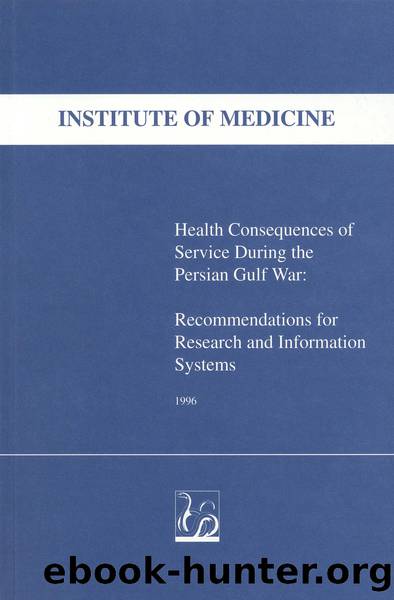Health Consequences of Service During the Persian Gulf War: Recommendations for Research and Information Systems by Committee to Review the Health Consequences of Service During the Persian Gulf War

Author:Committee to Review the Health Consequences of Service During the Persian Gulf War
Language: eng
Format: epub
Tags: Health and Medicine : Military and Veterans
Publisher: NATIONAL ACADEMY PRESS
Published: 1996-10-04T00:00:00+00:00
123rd Army Reserve Command (ARCOM)
The first "hot-pursuit" study was completed by investigators at Walter Reed Army Institute of Research (WRAIR) (DeFraites et al., 1992), who investigated reports of symptomatic complaints among reservists belonging to the 123rd ARCOM, Lafayette, Indiana. Staff of the 123rd ARCOM Surgeonâs Office became aware of these complaints early in 1992. Similar complaints were reported subsequently by members of the 417th Quartermaster Company, in Scottsburg, Indiana.
In response to growing concern about these reports, the team from WRAIR visited Fort Benjamin Harrison and neighboring facilities in April 1992. During this visit, 79 reservists who were concerned about their health were evaluated. All 79 participants completed a medical questionnaire, and 78 completed a Brief Symptom Inventory (BSI) and were available for a detailed interview. Each reservist interviewed completed a brief psychiatric intake-type interview and had vital signs measured. All but one of the reservists received a dental examination. All 78 who participated in the interviews also had blood drawn for complete blood count, white blood cell differential, platelet count, erythrocyte sedimentation rate, and liver function studies. All sera were tested for antibodies to Leishmania tropica. The performance characteristics of this test for use in screening have not been fully defined (DeFraites et al., 1992). Sera from selected individuals were tested for antibodies for brucellosis. Limited comparative data were available from other groups of veterans.
Fatigue was the most common symptom (70%). Other systemic symptoms, including fever, abdominal pain, and diarrhea, were less common. The onset of fatigue and associated symptoms tended to occur after redeployment from the PG; the onset of diarrhea was more frequent during deployment. No cases of leishmaniasis, brucellosis, or Lyme disease were detected. The findings did not suggest a common pattern of illness among study group members.
Review of potential exposures during Operation Desert Shield/Storm (ODS/S) provided no evidence that the respondents had exposures to microwaves, chemicals, radiation, or other suspected environmental hazards. These reservists did report high levels of stress. Investigators noted that the rapid deployment and subsequent redeployment were stressful for many reservists and their families. They believed, however, that PTSD was present in few, if any, of these reservists.
The investigators concluded that this study provided no objective evidence of an outbreak of any diagnosable disease in this group. They concluded that the documentable medical problems and illnesses found were typical of a general population with similar demographic characteristics. As investigators noted, this study provided no basis for defining a "case" of disease. No evidence of a common exposure was found.
DeFraites et al. (1992) reported that symptoms and objective findings seemed to appear in two peaks, one coincident with return from the Gulf and another some 6â8 months later. They could find no calendar month associations, clustering by activities, or evidence of any "dose-response" relationships with increasing length of time in the Gulf theater to suggest that at least some of the reported symptoms could be related to the reentry of these reservists. The largest proportion of illnesses that resulted in time lost from work was attributed to injuries and, thus, was recognized and explained.
Download
This site does not store any files on its server. We only index and link to content provided by other sites. Please contact the content providers to delete copyright contents if any and email us, we'll remove relevant links or contents immediately.
Parents as Care Managers by Gillian Bridge(697)
The Tapestry of Memory: Unraveling the Threads of the Mind by Bittner Karis & Chianese Gabriella & Priede PhD David L(539)
So Young, So Sad, So Listen: A Parents' Guide to Depression in Children and Young People by Philip Graham Nick Midgley(531)
Lucid Dying by Sam Parnia(472)
Vital Signs by Izzy Lomax-Sawyers(443)
Prepare the TCM License exam in a month Vol. 3: Acupuncture theory - channels, points, techniques and treatments(California, NCCAOM, Canadian exam) by Woosen Ur(390)
Oxford Textbook of Global Public Health by Roger Detels;Quarraisha Abdool Karim;Fran Baum;Liming Li;Alastair H Leyland;(358)
The Censorship of Second Opinions: How the politics of "misinformation" captured healthcare during the Covid-19 pandemic by Ariel Herron(342)
IVF Got This by Colette Centeno Fox(341)
Wilderness and Survival Medicine by Ellis Chris Breen & Dr Craig(280)
Introduction to Social Work Practice : A Practical Workbook by Herschel Knapp(279)
Eating and Growth Disorders in Infants and Children by Joseph L. Woolston(274)
How Data Happened by Unknown(257)
Boxed Set 1 Dermatology by Dr Miriam Kinai(256)
Selective Oxidation Catalysts Obtained by the Immobilization of Iron (III) Porphyrins on Layered Hydroxide Salts by Fernando Wypych Shirley Nakagaki & Guilherme Sippel Machado(246)
Zika Virus Biology, Transmission, and Pathways by Colin R. Martin(241)
Snake Oil: How Xi Jinping Shut Down the World by Michael P. Senger(237)
Positive health: 100+ research-based positive psychology and lifestyle medicine tools to enhance your wellbeing by Jolanta Burke Pádraic J. Dunne Trudy Meehan Ciaran A. O'Boyle Christian van Nieuwerburgh(233)
Global Health Governance and Commercialisation of Public Health in India by Anuj Kapilashrami Rama V. Baru(215)
